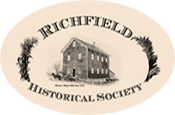Upcoming Events
Maple Syrup Family Day
March 22, 2025 ~ 9-4
.jpg) Enjoy a day outside at the Richfield Historical Park! Go early to have a tasty pancake breakfast. Then, wander over to the sugar shack, blacksmith shop and log buildings to see and do fun and interesting activities. Top it off with a hot dog and cocoa....Read More
Enjoy a day outside at the Richfield Historical Park! Go early to have a tasty pancake breakfast. Then, wander over to the sugar shack, blacksmith shop and log buildings to see and do fun and interesting activities. Top it off with a hot dog and cocoa....Read More
Note: Check here or the RHS Facebook page for a Cancellation Notice.
*****
2nd Annual
Maple Syrup Contest
 Are you a Wisconsin maple syrup producer? You have a great opportunity to enter your syrup in the Richfield Historical Society's 2nd Annual Maple Syrup contest.
Are you a Wisconsin maple syrup producer? You have a great opportunity to enter your syrup in the Richfield Historical Society's 2nd Annual Maple Syrup contest.
Just click the link below to read the Guidelines and Application Form.
2025 Maple Syrup Contest Guidelines and Application Form
*****
March 27, 2025: "American Veteran Cemeteries Around the World" presented by Al Buchholz -- Community Program at 7 pm, Richfield Fire Hall (2008 Hwy 175).
.jpg) Join us for an informative presentation on the American Cemeteries located in France, Italy, Belgium and Luxembourg. Mr. Buchholz’s has traveled extensively and visited these cemeteries...Read More
Join us for an informative presentation on the American Cemeteries located in France, Italy, Belgium and Luxembourg. Mr. Buchholz’s has traveled extensively and visited these cemeteries...Read More
*****
Call for Exhibitors
Art at the Mill
June 21,2025
2025 Guidelines & Application Form for Artists
2025 Guidelines & Application Form for Vendors
Note: Applications for Jewelry Artisans are no longer being accepted due to the quota being reached. If you wish to be placed on a waiting list, please contact artfairrhs@gmail.com
*****
Upcoming 2025 Monthly Programs
Learn about the Richfield Historical Park & Events Held
*****
RHS in Action
All-Member Recognition Picnic
The Richfield Historical Society is having an All-Member Recognition Picnic. You are invited to nominate a person(s) whom you feel meets the qualifications of the various awards. Just click on this link: Nomination Form

Inside the Messer/Mayer Mill and More
 Click on the photo to see a very interesting video about the Messer/Mayer Mill (you will even see the 3rd floor!)
Click on the photo to see a very interesting video about the Messer/Mayer Mill (you will even see the 3rd floor!)
*****
It's Maple Syrup Tree Tapping Time
Mother Nature cooperated enough for the maple trees in the Richfield Historical Park (1896 Hwy 164) to be tapped on Feb. 24. Sap is running from some of the trees but not many yet. Warm days and cool nights are needed. To learn about the process, visit the Sugar Shack.  The Maple Syrup Team is always willing to share their knowledge and may put you to work.
The Maple Syrup Team is always willing to share their knowledge and may put you to work.
Click on the photo above to view a video showing the Maple Syrup Team tapping maple trees.
*****
Question of the Week
The answer to the question "Does anyone remember what businesses were in this downtown Richfield building through the years?" is W.C. Harness Shop (See photo below). In later years, it housed the Schowalter Law Office, a dental office and Sabo of Slinger.

Next question: "What was once located on the hill south of the current Richfield Elementary School?"
Return on March 12 to see the answer.
*****
New Addition to the Richfield Historical Park
A new roadway and berm are being built in the Park. This will eventually allow water to flow into the raceway for the mill and the people mover at events will take visitors to the Lillicrapp Welcome Center. The road will be finished in spring after the ground thaws.
 - Index.jpg)
 - Index.jpg)
*****
Photos Entered in SPOOM Contest Won 1st Place for the Interior Category
The Society for the Preservation of Old Mills (SPOOM) has a photography contest. This year, RHS submitted photos along with this 'story':
In a homage titled "Time Stands Still," volunteers of Richfield Historical Park recreated a century-old photo capturing the  grist mill's interior. Motivated by its historical significance, the scene mirrors George Mayer, the owner in the original photo, with Al Mayer in
grist mill's interior. Motivated by its historical significance, the scene mirrors George Mayer, the owner in the original photo, with Al Mayer in  the contemporary role. Every detail resonates authentically, down to the broken piece of millstone gear resting on the table. The mill itself, housing original equipment like turbines, millstones, and sifters untouched since its closure over 70 years ago, stands as a testament frozen in time. Currently undergoing restoration by dedicated volunteers, the mill will resume operations in the future, offering visitors a glimpse into its 150-year-old history.
the contemporary role. Every detail resonates authentically, down to the broken piece of millstone gear resting on the table. The mill itself, housing original equipment like turbines, millstones, and sifters untouched since its closure over 70 years ago, stands as a testament frozen in time. Currently undergoing restoration by dedicated volunteers, the mill will resume operations in the future, offering visitors a glimpse into its 150-year-old history.
*****
Around the County Podcast Featuring the Richfield Historical Society
The Society's president, Pete Samson, and Vice President, Joni Crivello, participated in a podcast about the Society and the Historical Park. This podcast is part of the Around the County series sponsored by the Tower Heritage Center (Washington County Historical Society).
Click Here to listen to this interesting narrative (Episode #25).
*****
Past Features of RHS in Action

